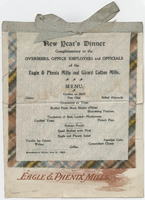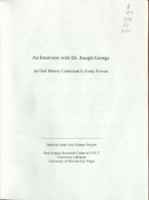Search the Special Collections and Archives Portal
Search Results
Bob Stupak practicing for Globetrotter Game and NY News Coverage of event: video
Date
Archival Collection
Description
"Practice session night before game" Bob Stupak plays basketball inside a gym; Stupak shooting free throws inside Madison Square Garden before the game; NY-One coverage of Stupak during the Globetrotter game; Stupak poses with $100,000 donation check. Original media VHS, color, aspect ratio 4 x 3, frame size 720 x 486. From the Bob Stupak Professional Papers (MS-01016) -- Professional papers -- Audiovisual material -- Digitized audiovisual clips file.
Moving Image

New Year's dinner for employees of the Eagle & Phenix Mills and Girard Cotton Mills, menu, January 6, 1904, Springer's Hotel
Date
Archival Collection
Description
Text
West, Charles I., 1908-1984
"Dr. Charles West was a prominent African-American figure who worked to advance the cause of civil rights in Southern Nevada.
Charles I. West was born in Washington, D.C. on September 27, 1908. His parents, Dr. Charles and Rebekah West, had four children.
Person
Albert C. Phillips Photograph Collection
Identifier
Abstract
The Albert C. Phillips Photograph Collection is comprised of sixteen black-and-white photographic reprints and four photographic negatives depicting buildings in Caliente, Nevada which were originally taken between 1900 to 1967 and reproduced in approximately 1999 to 2005.
Archival Collection
David Bedford Photograph Collection
Identifier
Abstract
The David Bedford Photograph Collection (approximately 1980-1984) is comprised of twenty color photographic prints that depict the Las Vegas, Nevada Ice House, which was constructed to aid transportation of perishable goods for the Los Angeles and Salt Lake Railroad.
Archival Collection
Charles Lanman Papers
Identifier
Abstract
Charles Lanman Papers (1864-1868) contain the title page of the Dictionary of the United States Congress and the General Government, written by Lanman, solicitation requests for biographical information from notable government figures, and written replies. Of interest with regard to Nevada are the original handwritten letters from James W. Nye and William M. Stewart.
Archival Collection

Laurents Bañuelos-Benitez oral history interview: transcript
Date
Archival Collection
Description
Oral history interview with Laurents Bañuelos-Benitez conducted by Rodrigo Vazquez and Barbara Tabach on June 16, 2021 for the Latinx Voices of Southern Nevada Oral History Project. Laurents is a Las Vegas native, graduate of Clark High School, and son of Mexican and Salvadoran immigrants. He is currently an English teacher at Rancho High School and was a former student worker on the Latinx Voices project.
Text

Transcript of interview with Dr. Joseph George Jr. by Emily Powers, April 8, 2008
Date
Archival Collection
Description
Text

Transcript of interview with Sari and Paul Aizley by Claytee D. White, November 4, 2016
Date
Archival Collection
Description
As Sari and Paul Aizley recall their separate childhoods and journeys to Las Vegas, their work and volunteer histories, their efforts to build a better society, and their life together they speak to each other as much as they respond to questions about their observations on the growth of the Las Vegas urban environment and their contributions to Southern Nevada's cultural development and a just society. In this interview, Sari and Paul speak to the cross-town commute and the physical UNLV campus in the late 1960s; the growth of the UNLV Math Department; the evolution of UNLV's Continuing Education; the State's North-South funding rivalry as reflected in the built environments of University of Nevada in Las Vegas and in Reno; plans to build a paleontology research facility at Tule Springs National Monument; the Review-Journal's "Ask Jessie Emmet" Real Estate column; local ACLU offices and politics; Fair Housing; transgendered persons; the Nevada State Assembly, and Class! magazine for Clark County high school students. Sari and Paul smile at each other as they recall how the editor/publisher met the bearded math professor and fell in love—despite the fact that they tell slightly different versions of their initial meeting(s). Sari passed away November 1, 2017, three days shy of one year after she participated in this interview.
Text

Interview with Harrie Fox Hess, March 5, 2005
Date
Archival Collection
Description
Text
